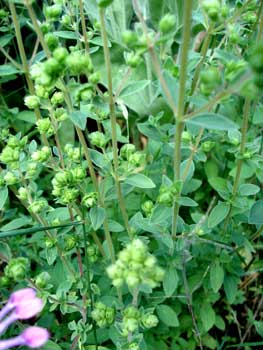
Cretan, Italian, or
Smyrna Oregeno,
Rhigani or Rigani; aka,
French, White, or
Pot Marjoram
"My love he went to Burdon Fair,
And of all the gifts that he saw there
Was none could his great love declare;
So he brought me marjoram smelling rare--
Its sweetness filled all the air."
-Alexander Hay Japp
1839-1905
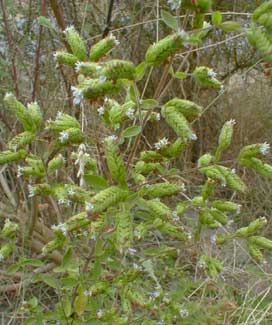 Cretan Oregano (Origanum onites) is one of the most flavorful culinary oreganos, although by about late July or in August it gets a bit woody & the flavor more bitter.
Cretan Oregano (Origanum onites) is one of the most flavorful culinary oreganos, although by about late July or in August it gets a bit woody & the flavor more bitter.When this happens it can be trimmed close to the ground to start over, or let it continue to be woody & harvest only August's tasty white flower heads, which are shown in some of these photos taken in three different years.
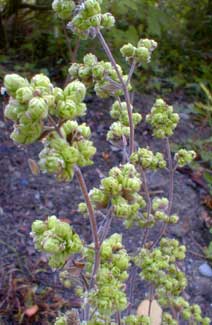 The leaves & flower heads can also be dried for use later in winter, though bear in mind that leaves & flowers are harvested separately, with only the young leaves being tasty, & the flowers occurring after it has gone woody & bitter.
The leaves & flower heads can also be dried for use later in winter, though bear in mind that leaves & flowers are harvested separately, with only the young leaves being tasty, & the flowers occurring after it has gone woody & bitter.Its most common use is in red sauces for pizzas or spaghetti, but it is versatile as a cooking herb. Some oreganos when overcooked lose all their flavor, but Cretan Oregano also called Pot Marjoram has a lasting flavor. It can be used raw on salads, cooked with just about anything, used either fresh or dried, or steeped for tonic teas.
Meat-eaters will want to cut it finely or crumble it dried & add it to ground round to make meatballs. As a vegetarian myself, I add it to veggie-balls made from sundry ground nuts, grated cheese, grated veggies, oats & crumbled bread, milk, eggs, & choice spices, very well mixed, shaped into balls on a cookie sheet for the oven.
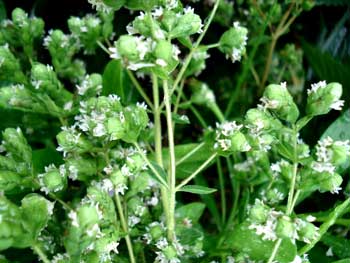 It has a spicy pungency in the garden. Plus, the flowers are nice enough, if only barely, to almost justify it as an ornamental. I'd actually planted it as an ornamental & kept it mainly because it was tasty stuff, but there was that first year when it bloomed I was quite disappointed in it & almost didn't keep it in the garden.
It has a spicy pungency in the garden. Plus, the flowers are nice enough, if only barely, to almost justify it as an ornamental. I'd actually planted it as an ornamental & kept it mainly because it was tasty stuff, but there was that first year when it bloomed I was quite disappointed in it & almost didn't keep it in the garden.But Granny Artemis insisted the flower was appealing in its oddity even if mostly just green, & the redolence of the leaves was a great addition to the path's edge. She would not let me take it out. Over time it's really grown on me, providing background texture amidst showier perennials. And it's so darned reliable in its extreme hardiness.
If flowers are harvested, the clump will rebloom up to September, being frost-hardy for an autumn presence. It grows very erect, a foot & a half to two feet in height, including flower heads.
It wants a position in full sunlight, but can tolerate a smidgen of shade. It prefers dryish very well-draining soil, but is adaptable to somewhat moister positions. Many xeric garden plants really do need periodic watering especially in summer, but this oregano is just about drought hardy enough to never be watered at all.
It also tolerates winds that would be desiccating for many other plants, & is not fussy as to soil type or pH. Clumps can be divided pre-spring or in autumn (March or October). After three years I noticed ours had become three clumps, & it really looks like some of it lodged (tipped over) & rooted along the stems.
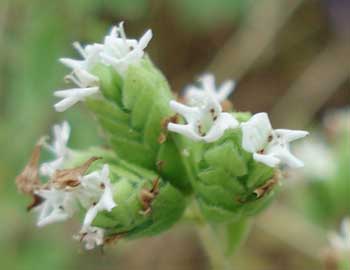 As a medicinal herb, the essential oils of Pot Marjoram possess antimicrobial & antioxidant properties, & no harmful side-effects. Most of the overly specific uses trumped up by herbal quacks have no scientific foundation, so not unsurprisingly Cretan Oregano is recommended for contradictory uses sometimes as a stimulant & elsetimes as a relaxant.
As a medicinal herb, the essential oils of Pot Marjoram possess antimicrobial & antioxidant properties, & no harmful side-effects. Most of the overly specific uses trumped up by herbal quacks have no scientific foundation, so not unsurprisingly Cretan Oregano is recommended for contradictory uses sometimes as a stimulant & elsetimes as a relaxant. Some claims for it are quite absurd, as when it is recommended for whooping cough or asthma. Homeopaths recommend it for "female complaints" & to regulate the menstrual cycle. This is completely without supporting evidence.
But on the level of settling an upset stomach it may be useful, & its antioxidants, equal in strength to the antioxidants in a russet potato or a strawberry, are naturally beneficial. Antioxidants are among the things that make most fresh fruits & veggies, nuts & spices, so very healthful. So even allowing that oreganos are probably nowhere near as "curative" as herbal pseudo-doctors & their easy marks insist, it is certainly at least a contributor to general health.
Cretan Oregano is thought to be the plant called Amaracus by Vergil, for which reason Amaracus was formerly used as the genus name for oreganos & marjorams. Vergil associates the herb as sacred to Aphrodite. It was used cultically for Aphrodite in the city of Idalia on Cyprus, the city itself named for the Goddess Cybele's home on Mount Ida; & it was used in Carthage, where Aphrodite was identified with Astarte. It was used in the marriage bed to insure good rutting, & it was also used to anoint pharaohs.